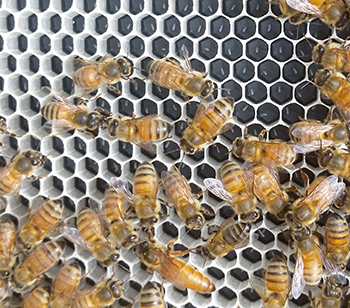
Long before temperatures plummet, the bees are preparing for winter. As soon as the days start getting shorter, it helps to start planning for winter, preparing your colony to survive the long dearth.
For colonies to survive the winter, you need healthy winter bees. Winter bees differ greatly from summer bees in their physiology. They have more fat body, special tissues that line the inside of their abdomen and produce a very important protein called vitellogenin (VG). This VG is an egg-yolk precursor normally used by insects in egg production, but repurposed in honey bees as an immune booster, energy reserve and predictor of longevity.
Colonies raise their winter bees predominantly in August and September, just as varroa mite levels peak nationwide. When mites rise above 3 mites per 100 bees, beekeepers need to do something to reduce the pressure of this parasite. Unfortunately samples from the National Honey Bee Disease Survey show that mite levels on average rise above this threshold from July-November.
Four Keys to Survival
For a colony to successfully survive the winter, four things need to be met in late summer.
- A high quality queen
- Low varroa pressure
- Plenty of incoming pollen
- A nectar flow
Quality Queen
A colony typically needs a large, healthy population to winter well. The queen must have a good brood pattern, laying a large number of eggs in late summer. These develop and emerge as healthy adult bees in August and September, becoming the winter bees of your cluster.
Big clusters winter much better than small clusters, as they can better thermoregulate colony temperatures. The larger size also allows the cluster to stay in contact with food stores more readily; they occupy more space and so can easily move up into additional stores. A small cluster may consume all the food in their vicinity during a cold snap, then starve with ample stores just out of reach.
If you have a poor quality queen in late summer, it is better to “pinch” (eliminate) her. If the remaining bees are healthy, combine them with another colony. It is much easier to winter one strong colony, than three weak ones. The strong one will come roaring through the winter and can then usually be split back out into three colonies the next spring.
Low Varroa Pressure
Varroa mites are a parasite that feed on both developing larvae and adult bees. We used to think they fed on bee blood, but new research by Dr. Samuel Ramsey has shown that these hungry tick-like parasites actually feed on honey bee fat body. Remember varroa naturally peaks in colonies right when colonies are rearing their winter bees and this pesky parasite is feeding on the fat body that produces VG. Bees add VG to brood food, a protein rich food that allows the larvae to grow rapidly. VG also allows bees to live longer and is abundant in winter bees. Bees parasitized by varroa are shorter lived. So if you want your bees to be healthy enough to make it through the winter, you need low varroa pressure in July, August and September.
Monitor your varroa levels: It’s best to monitor your varroa levels and have a management strategy in mind if levels exceed ….


